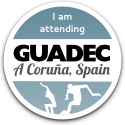We had a fantastic UX hackfest earlier this week. A group of 14 contributors spent two days in the Igalia office here in A Coruña. The brought together designers and developers, and gave us an opportunity to work through some high-priority design issues.
Here’s a brief report on what we got up to.
Day One
The first day was all about files and file selection. We started with a session on the ongoing work to improve Files (aka Nautilus). This covered the role of previews in Files and how that can be improved. We also discussed how we can improve search results for files in the Activities Overview.
We broke into two groups in the afternoon, and this let us get some Serious Work done. One group concentrated on menus in Nautilus. First we reviewed the current menus, including context menus and the new gear menu button. After that we developed a plan for how to better organise them. We made some excellent progress here; I’ll be working to distill our work into a concrete proposal soon.
The other group concentrated on the file chooser. A key goal here was to ensure that Nautilus and the file chooser are as consistent as possible. The group developed a set of use cases, identified goals and constraints, and then produced some mockups. Some great ideas came out of this session, and should hopefully filter into ongoing development work.
Day Two
We switched gears for the second day. The morning was spent reviewing the new initial setup assistant which is being worked on for GNOME 3.6. Jasper demonstrated his work in progress; we identified UX issues with the implementation as well as aspects of the design that could be improved. You can read our notes from that session on the wiki.
The afternoon was spent examining search within applications. We looked at search implementations in a range of GNOME apps, including System Settings, Documents, Contacts, Files and DevHelp, noting the advantages and disadvantages of each implementation. This enabled us to write a set of design guidelines for how search should be designed within applications. We also agreed a number of changes to the current search implementations in Contacts and Documents.
The hackfest was a great success. Each of the topics that we covered are important, and we made excellent progress on each of them. We will be working up and publishing the results of the event in the future.
As ever, one of the best things about the hackfest was the opportunity to work alongside other contributors. We had a fantastic group in attendance, including impressive new contributors all of whom had a positive impact. The event was a great opportunity to grow the GNOME design community.
I’d like to thank the hackfest sponsors – your support has been invaluable.






